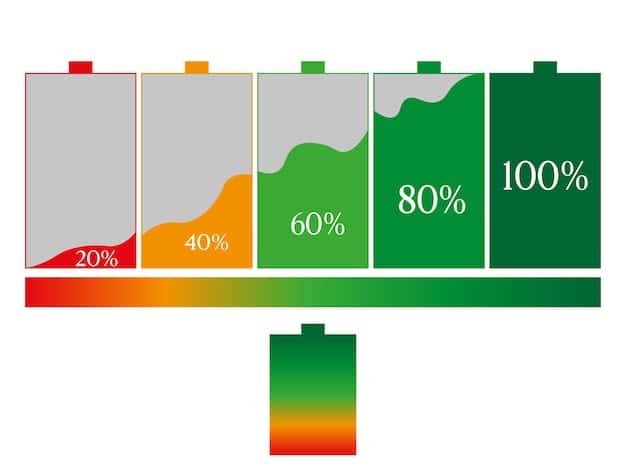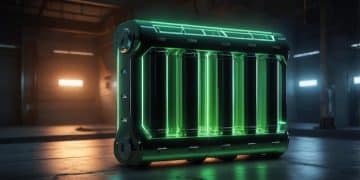Emerging Energy Storage Tech: Dominating the US Market by 2030

By 2030, the US energy storage market will likely be dominated by advanced lithium-ion batteries, flow batteries for long-duration storage, solid-state batteries offering enhanced safety and energy density, and potentially hydrogen storage solutions for large-scale, seasonal needs.
The landscape of energy storage is rapidly evolving, and anticipating what emerging energy storage technologies will dominate the US market by 2030 requires a look at current trends, technological advancements, and market forces shaping the energy sector.
forecasting the energy storage future in the us
Predicting the future of energy storage involves analyzing technological advancements, policy changes, and market demands. Several emerging technologies are vying for dominance, each with unique strengths and weaknesses. Understanding these dynamics is critical for stakeholders looking to invest in or utilize energy storage solutions.
As the US pushes towards a more sustainable energy future, the importance of energy storage cannot be overstated. It enables the integration of intermittent renewable energy sources, enhances grid stability, and provides backup power during outages.
key factors influencing energy storage adoption
Several factors will influence which technologies ultimately dominate the US market by 2030. These include cost reduction, performance improvements, safety enhancements, and regulatory support.
- cost competitiveness: The technology with the lowest cost per kilowatt-hour (kWh) over its lifecycle will likely see widespread adoption.
- performance metrics: Energy density, cycle life, and charge/discharge rates are critical performance indicators.
- safety standards: Technologies with inherent safety advantages will gain favor, especially for grid-scale applications.
- regulatory landscape: Government policies, incentives, and mandates will significantly impact the deployment of various energy storage solutions.
Ultimately, the successful energy storage technologies will be those that can effectively address all these factors, providing reliable, cost-effective, and safe energy solutions for a variety of applications.

lithium-ion batteries: an evolution, not a revolution?
While not a “new” technology, lithium-ion batteries continue to evolve and remain a strong contender for market dominance. Continuous improvements in energy density, cycle life, and cost are making them increasingly attractive for a wide range of applications.
Their established supply chain and widespread use in electric vehicles (EVs) provide a significant advantage over other emerging technologies. However, concerns about safety and raw material availability persist.
advancements in lithium-ion technology
Researchers are actively working on improving lithium-ion batteries through various modifications to their chemistry and design.
- nickel-rich cathodes: Increasing the nickel content in cathodes boosts energy density but requires careful thermal management to prevent overheating.
- silicon anodes: Replacing graphite with silicon in anodes can significantly increase energy density but poses challenges related to volume expansion during charging and discharging.
- advanced electrolytes: Solid or semi-solid electrolytes offer improved safety and higher energy density compared to conventional liquid electrolytes.
While these advancements promise to enhance the performance and safety of lithium-ion batteries, they also introduce new manufacturing complexities and cost considerations.
Despite the competition from other emerging technologies, lithium-ion batteries are expected to maintain a significant share of the energy storage market due to their established infrastructure, continuous improvements, and versatility.
flow batteries: the long-duration storage solution
Flow batteries are emerging as a promising solution for long-duration energy storage (LDES), which is essential for balancing the grid with high penetrations of renewable energy. Unlike traditional batteries that store energy in fixed electrodes, flow batteries store energy in liquid electrolytes housed in external tanks.
This design allows for independent scaling of energy capacity and power output, making them well-suited for applications requiring several hours of discharge time.
types of flow batteries
Several types of flow batteries are under development, each with its own advantages and disadvantages.
- vanadium redox flow batteries (VRFBs): These are the most mature flow battery technology, offering long cycle life and high efficiency.
- iron-chromium flow batteries: These batteries use earth-abundant materials, making them a potentially low-cost alternative to VRFBs.
- organic flow batteries: These batteries use organic electrolytes, which can be derived from sustainable sources.
The choice of flow battery technology will depend on specific application requirements, such as cost, performance, and environmental considerations.
Flow batteries are positioned to play a crucial role in grid-scale energy storage, enabling greater penetration of renewable energy sources and enhancing grid resilience.
solid-state batteries: a game-changer on the horizon?
Solid-state batteries replace the liquid electrolyte in conventional lithium-ion batteries with a solid electrolyte. This offers several potential advantages, including higher energy density, improved safety, and longer cycle life.
However, solid-state batteries are still in the early stages of development, and significant challenges remain before they can be mass-produced at a competitive cost.
advantages of solid-state batteries
The potential benefits of solid-state batteries are driving significant research and development efforts.
- enhanced safety: Solid electrolytes are non-flammable, reducing the risk of fire or explosion.
- higher energy density: Solid-state batteries can use higher-voltage cathodes, resulting in higher energy density.
- longer cycle life: Solid electrolytes are more stable than liquid electrolytes, leading to longer cycle life.
Overcoming the manufacturing challenges and achieving cost parity with lithium-ion batteries are critical for the widespread adoption of solid-state batteries.
Solid-state batteries have the potential to disrupt the energy storage market, offering a safer, more efficient, and longer-lasting energy storage solution.

hydrogen storage: the ultimate long-term solution?
Hydrogen storage involves storing energy in the form of hydrogen gas. Hydrogen can be produced from various sources, including renewable energy, and can be stored for long periods of time. It can then be used to generate electricity or as a fuel for transportation.
Hydrogen storage is gaining attention as a potential solution for large-scale, seasonal energy storage, addressing the intermittency of renewable energy sources over extended periods.
methods of hydrogen storage
Several methods of hydrogen storage are being explored, each with its own advantages and disadvantages.
- compressed hydrogen: Storing hydrogen as a compressed gas requires high-pressure tanks.
- liquid hydrogen: Liquefying hydrogen requires cryogenic temperatures.
- chemical hydrogen storage: Storing hydrogen in chemical compounds, such as ammonia or metal hydrides.
Developing cost-effective and efficient methods of hydrogen storage is essential for its widespread adoption.
Hydrogen storage has the potential to play a significant role in a future energy system powered by renewable energy, providing long-term storage and fuel for various sectors.
beyond batteries: alternative energy storage technologies
While batteries and hydrogen storage are leading contenders, other energy storage technologies are also emerging and could play a significant role in the future energy landscape.
These technologies include mechanical energy storage, thermal energy storage, and compressed air energy storage.
mechanical energy storage
Mechanical energy storage technologies store energy through physical means.
- pumped hydro storage: Pumping water uphill to a reservoir and then releasing it to generate electricity.
- flywheel energy storage: Storing energy in a rotating mass.
thermal energy storage
Thermal energy storage technologies store energy in the form of heat or cold.
- molten salt storage: Storing heat from concentrated solar power plants in molten salt.
- ice storage: Storing cold for cooling applications.
compressed air energy storage
Compressed air energy storage (CAES) involves compressing air and storing it in underground caverns or tanks. When electricity is needed, the compressed air is released and used to drive a turbine.
These alternative storage technologies offer unique advantages for specific applications and could contribute to a more diverse and resilient energy storage portfolio.
| Key Aspect | Brief Description |
|---|---|
| ⚡Lithium-Ion Batteries | Evolving technology with incremental improvements. |
| 🔋Flow Batteries | Ideal for long-duration grid storage solutions. |
| 🛡️Solid-State Batteries | Offers enhanced safety and energy density. |
| 💧Hydrogen Storage | Long-term solution for seasonal energy needs. |
Frequently Asked Questions
▼
Lithium-ion batteries benefit from a mature supply chain, ongoing technological advancements, and cost reductions, making them a versatile option despite the emergence of newer technologies.
▼
Flow batteries offer long-duration storage capabilities, essential for balancing intermittent renewable energy sources like solar and wind, thus enhancing grid stability and reliability.
▼
Solid-state batteries use a non-flammable solid electrolyte, eliminating the risk of fire associated with the liquid electrolytes used in traditional lithium-ion batteries.
▼
Hydrogen storage offers a means to store large quantities of energy for extended periods, making it suitable for seasonal energy demands and balancing long-term renewable energy fluctuations.
▼
Yes, alternative technologies such as pumped hydro storage, compressed air energy storage, and thermal energy storage offer unique advantages for specific applications and grid needs.
conclusion
The US energy storage market in 2030 will likely be characterized by a diverse mix of technologies, each playing a role in enabling a more resilient and sustainable energy system. While lithium-ion batteries will continue to evolve and maintain a strong presence, flow batteries, solid-state batteries, and hydrogen storage solutions are poised to make significant inroads, driven by their unique capabilities and the growing demand for long-duration storage and enhanced safety.





